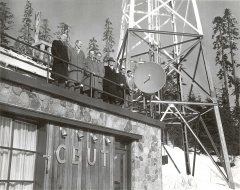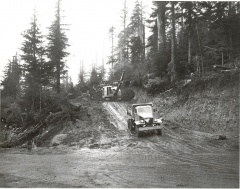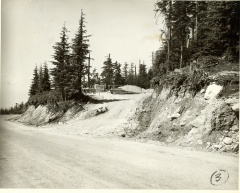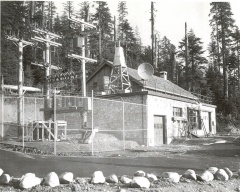Milestones:First Television Broadcast in Western Canada, 1953: Difference between revisions
No edit summary |
No edit summary |
||
| Line 1: | Line 1: | ||
== First television broadcast in Western Canada, 1953 == | == First television broadcast in Western Canada, 1953 == | ||
[[Image:Mt Seymour 01.jpg|thumb|right|240px|Construction of the CBC Broadcasting Site on Mount Seymour begins, 1953. | [[Image:Mt Seymour 01.jpg|thumb|right|240px|Construction of the CBC Broadcasting Site on Mount Seymour begins, 1953. | ||
This and the following historical photographs were provided by CBC Transmission, Vancouver.]] | This and the following historical photographs were provided by CBC Transmission, Vancouver.]] | ||
| Line 14: | Line 11: | ||
[[Image:150px-CBUT logo 1953-76.jpg|frame|right|The logo used by CBUT - channel 2 from its commissioning in 1953 until a new system-wide corporate logo was introduced in 1976.]] | [[Image:150px-CBUT logo 1953-76.jpg|frame|right|The logo used by CBUT - channel 2 from its commissioning in 1953 until a new system-wide corporate logo was introduced in 1976.]] | ||
The CBUT broadcasting site on Mount Seymour (North Vancouver, British Columbia) was both the first television broadcasting site in Western Canada and the first high elevation/mountain top broadcasting site in Canada. The opening broadcast featured special launch ceremonies at 6 pm and was followed by a CBC newscast at 7 pm. | |||
''On 16 December 1953, the first television broadcast in Western Canada was transmitted from this site by the Canadian Broadcasting Corporation's CBUT Channel 2. The engineering experience gained here was instrumental in the subsequent establishment of the more than one thousand public and private television broadcasting sites that serve Western Canada today.'' | |||
'''Plaque will be viewable on a wall near the main gate of the CBC Broadcasting Site on Mount Seymour just below the Mount Seymour Ski Area. ''' | |||
The CBUT broadcasting site on Mount Seymour (North Vancouver, British Columbia) was both the first television broadcasting site in Western Canada and the first high elevation/mountain top broadcasting site in Canada. The opening broadcast featured special launch ceremonies at 6 pm and was followed by a CBC newscast at 7 pm. (Western Canada refers to the four provinces west of the Great Lakes: British Columbia, Alberta, Saskatchewan and Manitoba. It is physically separated from Central Canada (Ontario and Quebec) by the Great Lakes and the relatively inhospitable Canadian Shield.) | |||
At the time of the first broadcast, the establishment of a television station in Vancouver was seen as an important contribution to Canadian sovereignty and cultural identity. The first broadcast and associated ceremonies were major events. At the same time, CBUT provided an important training ground for and contributed to the principles and practices that guided the engineers who went on to deploy the over 1000 public and private broadcasting sites that serve Western Canada today. | At the time of the first broadcast, the establishment of a television station in Vancouver was seen as an important contribution to Canadian sovereignty and cultural identity. The first broadcast and associated ceremonies were major events. At the same time, CBUT provided an important training ground for and contributed to the principles and practices that guided the engineers who went on to deploy the over 1000 public and private broadcasting sites that serve Western Canada today. | ||
| Line 20: | Line 22: | ||
Although VHF transmitting sites had already been established in Western Canada for FM broadcasting, these sites were generally located atop tall buildings in urban areas, e.g., VE9FG (later CBU-FM), a 1-kW FM broadcast station that became operational on 21 November 1947 and which was located at the Hotel Vancouver in downtown Vancouver''.'' | Although VHF transmitting sites had already been established in Western Canada for FM broadcasting, these sites were generally located atop tall buildings in urban areas, e.g., VE9FG (later CBU-FM), a 1-kW FM broadcast station that became operational on 21 November 1947 and which was located at the Hotel Vancouver in downtown Vancouver''.'' | ||
The three television broadcasting sites that had been established in Canada previously (in Montreal, Toronto and Ottawa) were also installed at relatively low elevations. For the CBC managers of the day, establishing the network’s fourth television transmitter so far West and at a high elevation and a remote location was a bold and significant decision. | The three television broadcasting sites that had been established in Canada previously (in Montreal, Toronto and Ottawa) were also installed at relatively low elevations. For the CBC managers of the day, establishing the network’s fourth television transmitter so far West and at a high elevation and a remote location was a bold and significant decision. | ||
The relatively complicated topography of the Lower Mainland of British Columbia required that considerable care be taken to choose a broadcasting site that would provide the best coverage. Predicting and evaluating the coverage of a VHF broadcast transmitter in mountainous terrain is much different from the corresponding task for the MF broadcast transmitters that had been installed at various low-level locations throughout the Lower Mainland during the 1930‘s and 1940‘s. <br> | The relatively complicated topography of the Lower Mainland of British Columbia required that considerable care be taken to choose a broadcasting site that would provide the best coverage. Predicting and evaluating the coverage of a VHF broadcast transmitter in mountainous terrain is much different from the corresponding task for the MF broadcast transmitters that had been installed at various low-level locations throughout the Lower Mainland during the 1930‘s and 1940‘s. <br> | ||
The quality of the initial site selection and engineering is underscored by the longevity of the CBC Broadcasting Site on Mount Seymour and the large number of other television and FM broadcast transmitters that are installed in the same general area today, including: | The quality of the initial site selection and engineering is underscored by the longevity of the CBC Broadcasting Site on Mount Seymour and the large number of other television and FM broadcast transmitters that are installed in the same general area today, including: | ||
'''FM stations''' | '''FM stations''' | ||
*BU-1-FM 88.1 (CBC Radio One) | |||
*CBUX-FM 90.9 (Espace Musique) | |||
*CKYE-FM 93.1 (Red FM) | |||
*CJJR-FM 93.7 (JR-FM) | |||
*CFBT-FM 94.5 (The Beat 94.5) | |||
*CKZZ-FM 95.3 (Virgin Radio 95.3) | |||
*CHKG-FM 96.1 (Fairchild Radio) | |||
*CKLG-FM 96.9 (Jack FM) | |||
*CBUF-FM 97.7 (Première Chaîne) | |||
*CFOX-FM 99.3 (99.3 The Fox) | |||
*CFMI-FM 101.1 (Rock 101) | |||
*CFRO-FM 102.7 (Co-Op Radio) | |||
*CHQM-FM 103.5 (103.5 QM/FM) | |||
*CFUN-FM-2 104.9 (104.9 Fun FM) | |||
*CBU-FM 105.7 (CBC Radio 2) | |||
*CKAV-FM-2 106.3 (Aboriginal Voices Radio) | |||
CBUT-TV (CBC): VHF 2 (NTSC), UHF 58 (ATSC) | '''TV stations''' | ||
*CBUT-TV (CBC): VHF 2 (NTSC), UHF 58 (ATSC) | |||
*CHAN-TV (Global): VHF 8 (NTSC) UHF 22 (ATSC) | |||
*CIVI-TV-2 (rebroadcaster of CIVI-TV, A): UHF 17 (NTSC) | |||
*CBUFT-TV (Radio-Canada): UHF 26 (ATSC) | |||
*CIVT-TV (CTV): UHF 32 (NTSC), UHF 33 (ATSC) | |||
*CHNM-TV (OMNI): UHF 42 (NTSC) | |||
== References and Further Reading == | == References and Further Reading == | ||
| Line 38: | Line 62: | ||
Broadcasting in Canada: History and Development of the National System, CBC, 1962, 92 pp. | Broadcasting in Canada: History and Development of the National System, CBC, 1962, 92 pp. | ||
A Brief History of the Canadian Broadcasting Corporation, CBC, 1976, 40 pp. | |||
A Brief History of the Canadian Broadcasting Corporation, CBC, 1976, 40 pp. | |||
Also see: | Also see: | ||
| Line 55: | Line 78: | ||
== Proposal and Nomination == | == Proposal and Nomination == | ||
[[Milestone-Proposal:First television broadcast in Western Canada| | [[Milestone-Proposal:First television broadcast in Western Canada|First Television Broadcast in Western Canada Proposal]] | ||
[[Milestone-Nomination:First television broadcast in Western Canada| | [[Milestone-Nomination:First television broadcast in Western Canada|First Television Broadcast in Western Canada Nomination]] | ||
<div class="header"><span class="head1">INNOVATION</span><span class="head2"> MAP</span></div> | <div class="header"><span class="head1">INNOVATION</span><span class="head2"> MAP</span></div> | ||
Revision as of 13:00, 18 June 2012
First television broadcast in Western Canada, 1953

On 16 December 1953, the first television broadcast in Western Canada was transmitted from this site by the Canadian Broadcasting Corporation's CBUT Channel 2. The engineering experience gained here was instrumental in the subsequent establishment of the more than one thousand public and private television broadcasting sites that serve Western Canada today.
Plaque will be viewable on a wall near the main gate of the CBC Broadcasting Site on Mount Seymour just below the Mount Seymour Ski Area.
The CBUT broadcasting site on Mount Seymour (North Vancouver, British Columbia) was both the first television broadcasting site in Western Canada and the first high elevation/mountain top broadcasting site in Canada. The opening broadcast featured special launch ceremonies at 6 pm and was followed by a CBC newscast at 7 pm. (Western Canada refers to the four provinces west of the Great Lakes: British Columbia, Alberta, Saskatchewan and Manitoba. It is physically separated from Central Canada (Ontario and Quebec) by the Great Lakes and the relatively inhospitable Canadian Shield.)
At the time of the first broadcast, the establishment of a television station in Vancouver was seen as an important contribution to Canadian sovereignty and cultural identity. The first broadcast and associated ceremonies were major events. At the same time, CBUT provided an important training ground for and contributed to the principles and practices that guided the engineers who went on to deploy the over 1000 public and private broadcasting sites that serve Western Canada today.
Although VHF transmitting sites had already been established in Western Canada for FM broadcasting, these sites were generally located atop tall buildings in urban areas, e.g., VE9FG (later CBU-FM), a 1-kW FM broadcast station that became operational on 21 November 1947 and which was located at the Hotel Vancouver in downtown Vancouver.
The three television broadcasting sites that had been established in Canada previously (in Montreal, Toronto and Ottawa) were also installed at relatively low elevations. For the CBC managers of the day, establishing the network’s fourth television transmitter so far West and at a high elevation and a remote location was a bold and significant decision.
The relatively complicated topography of the Lower Mainland of British Columbia required that considerable care be taken to choose a broadcasting site that would provide the best coverage. Predicting and evaluating the coverage of a VHF broadcast transmitter in mountainous terrain is much different from the corresponding task for the MF broadcast transmitters that had been installed at various low-level locations throughout the Lower Mainland during the 1930‘s and 1940‘s.
The quality of the initial site selection and engineering is underscored by the longevity of the CBC Broadcasting Site on Mount Seymour and the large number of other television and FM broadcast transmitters that are installed in the same general area today, including:
FM stations
- BU-1-FM 88.1 (CBC Radio One)
- CBUX-FM 90.9 (Espace Musique)
- CKYE-FM 93.1 (Red FM)
- CJJR-FM 93.7 (JR-FM)
- CFBT-FM 94.5 (The Beat 94.5)
- CKZZ-FM 95.3 (Virgin Radio 95.3)
- CHKG-FM 96.1 (Fairchild Radio)
- CKLG-FM 96.9 (Jack FM)
- CBUF-FM 97.7 (Première Chaîne)
- CFOX-FM 99.3 (99.3 The Fox)
- CFMI-FM 101.1 (Rock 101)
- CFRO-FM 102.7 (Co-Op Radio)
- CHQM-FM 103.5 (103.5 QM/FM)
- CFUN-FM-2 104.9 (104.9 Fun FM)
- CBU-FM 105.7 (CBC Radio 2)
- CKAV-FM-2 106.3 (Aboriginal Voices Radio)
TV stations
- CBUT-TV (CBC): VHF 2 (NTSC), UHF 58 (ATSC)
- CHAN-TV (Global): VHF 8 (NTSC) UHF 22 (ATSC)
- CIVI-TV-2 (rebroadcaster of CIVI-TV, A): UHF 17 (NTSC)
- CBUFT-TV (Radio-Canada): UHF 26 (ATSC)
- CIVT-TV (CTV): UHF 32 (NTSC), UHF 33 (ATSC)
- CHNM-TV (OMNI): UHF 42 (NTSC)
References and Further Reading
The historical context of the CBUT broadcasting site on Mount Seymour has been documented in:
Broadcasting in Canada: History and Development of the National System, CBC, 1962, 92 pp.
A Brief History of the Canadian Broadcasting Corporation, CBC, 1976, 40 pp.
Also see:
"CBC Chief in City", 15 December 1953. Television Transmitter, Mount Seymour Docket 1, Vancouver City Archives.
Anne Kloppenborg, Ed., Vancouver's first century : a city album 1860-1960, Vancouver : J.J. Douglas, 1977.
Canadian Communications Foundation (Official site).
Letter from the site owner giving permission to place IEEE milestone plaque on the property
Proposal and Nomination
First Television Broadcast in Western Canada Proposal
First Television Broadcast in Western Canada Nomination
<googlemap controls="small" height="250" width="300" zoom="10" lon="-122.956667" lat="49.353611" version="0.9"> 49.353611,-122.956667 CBC Broadcasting Site, Vancouver, Canada</googlemap>



